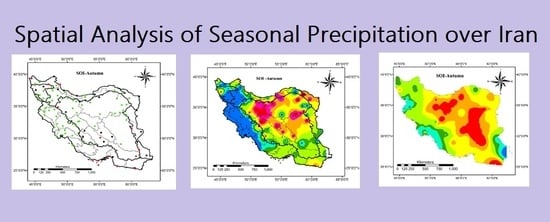Spatial Analysis of Seasonal Precipitation over Iran: Co-Variation with Climate Indices
Abstract
1. Introduction
2. Materials and Methods
2.1. Study Area
2.2. Data
2.2.1. Rainfall
2.2.2. Climate Indices: El Niño-Southern Oscillation
2.2.3. Climate Indices: North Atlantic Oscillation (NAO)
2.2.4. Climate Indices: Pacific Decadal Oscillation (PDO)
2.3. Spatial Characteristics of Rainfall for the Various Seasons
2.4. Analyses of the Correlation between Rainfall and Climate Indices
3. Results
4. Conclusions
Author Contributions
Funding
Conflicts of Interest
Appendix A
| Station Name | Annual Average (mm) | X (Degree) | Y (Degree) | Elevation (m) | Station Name | Annual Average (mm) | X (Degree) | Y (Degree) | Elevation (m) |
|---|---|---|---|---|---|---|---|---|---|
| Abadan | 150 | 48.25 | 30.37 | 7 | Ghoochan | 314 | 58.50 | 37.07 | 1287 |
| Abade | 129 | 52.67 | 31.18 | 2030 | Gonabad | 129 | 58.68 | 34.35 | 1056 |
| Abali | 546 | 51.88 | 35.75 | 2465 | Gorgan | 515 | 54.27 | 36.85 | 13 |
| Abumoosa | 127 | 54.83 | 25.83 | 7 | Hamedan | 301 | 48.53 | 34.87 | 1742 |
| Ahar | 285 | 47.07 | 38.43 | 1391 | Ilam | 562 | 46.43 | 33.63 | 1337 |
| Ahwaz | 210 | 48.67 | 31.33 | 23 | Iranshahr | 105 | 60.70 | 27.20 | 591 |
| Aligoodarz | 388 | 49.70 | 33.40 | 2022 | Isfahan | 129 | 51.67 | 32.62 | 1550 |
| Anar | 69 | 55.25 | 30.88 | 1409 | Islam abad | 462 | 46.47 | 34.12 | 1349 |
| Arak | 298 | 49.77 | 34.10 | 1708 | Jask | 115 | 57.77 | 25.63 | 5 |
| Ardabil | 278 | 48.28 | 38.25 | 1332 | Jolfa | 212 | 45.67 | 38.75 | 736 |
| Astara | 1359 | 48.87 | 38.42 | 18 | Kangavar | 384 | 47.98 | 34.50 | 1468 |
| Babolsar | 912 | 52.65 | 36.72 | −21 | Karaj | 246 | 50.90 | 35.92 | 1313 |
| Bam | 56 | 58.35 | 29.10 | 1067 | Kashan | 127 | 51.45 | 33.98 | 982 |
| Bandar Abbas | 171 | 56.37 | 27.22 | 10 | Kashmar | 187 | 58.47 | 35.20 | 1110 |
| Bandar-e-Anzali | 1730 | 49.47 | 37.47 | 26 | Kerman | 128 | 56.97 | 30.25 | 1754 |
| Bandar-e-Lenge | 130 | 54.83 | 26.53 | 23 | Kermanshah | 411 | 47.15 | 34.35 | 1319 |
| Bandar-e-Mahshahr | 197 | 49.15 | 30.55 | 6 | Khalkhal | 370 | 48.52 | 37.63 | 1796 |
| Bijar | 334 | 47.62 | 35.88 | 1883 | Khash | 147 | 61.20 | 28.22 | 1394 |
| Birjand | 151 | 59.20 | 32.87 | 1491 | Khoorbiabanak | 76 | 55.08 | 33.78 | 845 |
| Bojnurd | 252 | 57.32 | 37.47 | 1091 | Khoramabad | 469 | 48.28 | 33.43 | 1148 |
| Boshruye | 86 | 57.45 | 33.90 | 885 | Khoramdareh | 295 | 49.18 | 36.18 | 1575 |
| Bostan | 195 | 48.00 | 31.72 | 8 | Khoy | 262 | 44.97 | 38.55 | 1103 |
| Brojen | 250 | 51.30 | 31.95 | 2197 | Kish | 155 | 53.98 | 26.50 | 30 |
| Bushehr | 255 | 50.83 | 28.98 | 20 | Koohrang | 1336 | 50.12 | 32.43 | 2285 |
| Bushehr (Coastal) | 252 | 50.82 | 28.90 | 8 | Mahabad | 393 | 45.72 | 36.77 | 1385 |
| Chabahar | 117 | 60.62 | 25.28 | 8 | Makoo | 302 | 44.43 | 39.33 | 1411 |
| Dezful | 313 | 48.42 | 32.27 | 83 | Maragheh | 279 | 46.27 | 37.40 | 1478 |
| Dogonbadan | 420 | 50.77 | 30.43 | 700 | Mashhad | 242 | 59.63 | 36.27 | 999 |
| Fassa | 285 | 53.68 | 28.97 | 1288 | Masjed Soleyman | 399 | 49.28 | 31.93 | 321 |
| Ferdos | 128 | 58.17 | 34.02 | 1293 | Minab | 206 | 57.08 | 27.10 | 30 |
| Garmsar | 111 | 52.27 | 35.20 | 825 | Miyaneh | 276 | 47.70 | 37.45 | 1110 |
| Ghaen | 161 | 59.17 | 33.72 | 1432 | Nehbandan | 121 | 60.03 | 31.53 | 1211 |
| Gharakhil | 718 | 52.77 | 36.45 | 15 | Noushahr | 1303 | 51.50 | 36.65 | −21 |
| Ghazvin | 312 | 50.05 | 36.25 | 1279 | Omidiye | 256 | 49.67 | 30.77 | 27 |
| Ghom | 137 | 50.85 | 34.70 | 877 | Pars Abad | 276 | 47.92 | 39.65 | 32 |
| Station Name | Annual Average (mm) | X (Degree) | Y (Degree) | Elevation (m) |
|---|---|---|---|---|
| Piranshahr | 646 | 45.13 | 36.67 | 1455 |
| Ramhormoz | 292 | 49.60 | 31.27 | 151 |
| Ramsar | 1227 | 50.67 | 36.90 | −20 |
| Rasht | 1322 | 49.65 | 37.20 | 37 |
| Ravansar | 500 | 46.65 | 34.72 | 1380 |
| Sabzevar | 185 | 57.72 | 36.20 | 978 |
| Sad-e- Drudzan | 458 | 52.43 | 30.22 | 1620 |
| Saghez | 445 | 46.27 | 36.25 | 1523 |
| Sanandaj | 378 | 47.00 | 35.33 | 1373 |
| Sar Pol Zahab | 411 | 45.87 | 34.45 | 545 |
| Sarab | 239 | 47.53 | 37.93 | 1682 |
| Sarakhs | 191 | 61.17 | 36.53 | 235 |
| Saravan | 106 | 62.33 | 27.33 | 1195 |
| Sardasht | 823 | 45.50 | 36.15 | 1670 |
| Semnan | 135 | 53.55 | 35.58 | 1131 |
| Shahr-e-Babak | 151 | 55.13 | 30.10 | 1834 |
| Shahrkord | 320 | 50.85 | 32.28 | 2049 |
| Shahrud | 152 | 54.95 | 36.42 | 1345 |
| Shamiran | 414 | 51.62 | 35.78 | 1976 |
| Shargh-e-Isfahan | 103 | 51.87 | 32.67 | 1543 |
| Shiraz | 323 | 52.60 | 29.53 | 1484 |
| Sirjan | 139 | 55.68 | 29.47 | 1739 |
| Tabas | 78 | 56.92 | 33.60 | 711 |
| Tabriz | 246 | 46.28 | 38.08 | 1361 |
| Takab | 318 | 47.12 | 36.38 | 1765 |
| Tehran | 228 | 51.38 | 35.73 | 1419 |
| Torbat-e-Heydariyeh | 253 | 59.22 | 35.27 | 1451 |
| Urmia | 302 | 45.08 | 37.53 | 1316 |
| Yasuj | 797 | 51.68 | 30.83 | 1832 |
| Yazd | 51 | 54.28 | 31.90 | 1237 |
| Zabol | 54 | 61.48 | 31.03 | 489 |
| Zahedan | 76 | 60.88 | 29.47 | 1370 |
| Zanjan | 284 | 48.48 | 36.68 | 1663 |
References
- Le Houérou, H.N. Climate change, drought and desertification. J. Arid Environ. 1996, 34, 133–185. [Google Scholar] [CrossRef]
- Choubin, B.; Mosavi, A.; Alamdarloo, E.H.; Hosseini, F.S.; Shamshirband, S.; Dashtekian, K.; Ghamisi, P. Earth fissure hazard prediction using machine learning models. Environ. Res. 2019, 179, 108770. [Google Scholar] [CrossRef] [PubMed]
- Trenberth, K.E. Changes in precipitation with climate change. Clim. Res. 2011, 47, 123–138. [Google Scholar] [CrossRef]
- Salehi, S.; Dehghani, M.; Mortazavi, S.M.; Singh, V.P. Trend analysis and change point detection of seasonal and annual precipitation in Iran. Int. J. Climatol. 2019. [Google Scholar] [CrossRef]
- Biabanaki, M.; Eslamian, S.S.; Koupai, J.A.; Cañón, J.; Boni, G.; Gheysari, M. A principal components/singular spectrum analysis approach to ENSO and PDO influences on rainfall in western Iran. Hydrol. Res. 2013, 45, 250–262. [Google Scholar] [CrossRef]
- Shahi, A. Drought: The Achilles heel of the Islamic Republic of Iran. Asian Aff. 2019, 50, 18–39. [Google Scholar] [CrossRef]
- Sabziparvar, A.; Mirmasoudi, S.; Tabari, H.; Nazemosadat, M.; Maryanaji, Z. ENSO teleconnection impacts on reference evapotranspiration variability in some warm climates of Iran. Int. J. Climatol. 2011, 31, 1710–1723. [Google Scholar] [CrossRef]
- Onyutha, C.; Willems, P. Spatial and temporal variability of rainfall in the Nile Basin. Hydrol. Earth Syst. Sci. 2015, 19, 2227–2246. [Google Scholar] [CrossRef]
- Rau, P.; Bourrel, L.; Labat, D.; Melo, P.; Dewitte, B.; Frappart, F.; Lavado, W.; Felipe, O. Regionalization of rainfall over the Peruvian Pacific slope and coast. Int. J. Climatol. 2017, 37, 143–158. [Google Scholar] [CrossRef]
- Rutkowska, A.; Willems, P.; Onyutha, C.; Młocek, W. Temporal and spatial variability of extreme river flow quantiles in the Upper Vistula River basin, Poland. Hydrol. Process. 2017, 31, 1510–1526. [Google Scholar] [CrossRef]
- Onyutha, C.; Willems, P. Space-time variability of extreme rainfall in the River Nile basin. Int. J. Climatol. 2017, 37, 4915–4924. [Google Scholar] [CrossRef]
- Ahokpossi, Y. Analysis of the rainfall variability and change in the Republic of Benin (West Africa). Hydrol. Sci. J. 2018, 63, 2097–2123. [Google Scholar] [CrossRef]
- Sulca, J.; Takahashi, K.; Espinoza, J.C.; Vuille, M.; Lavado-Casimiro, W. Impacts of different ENSO flavors and tropical Pacific convection variability (ITCZ, SPCZ) on austral summer rainfall in South America, with a focus on Peru. Int. J. Climatol. 2018, 38, 420–435. [Google Scholar] [CrossRef]
- Dasari, H.P.; Langodan, S.; Viswanadhapalli, Y.; Vadlamudi, B.R.; Papadopoulos, V.P.; Hoteit, I. ENSO influence on the interannual variability of the Red Sea convergence zone and associated rainfall. Int. J. Climatol. 2018, 38, 761–775. [Google Scholar] [CrossRef]
- Abid, M.A.; Almazroui, M.; Kucharski, F.; O’Brien, E.; Yousef, A.E. ENSO relationship to summer rainfall variability and its potential predictability over Arabian Peninsula region. Npj Clim. Atmos. Sci. 2018, 1, 20171. [Google Scholar] [CrossRef]
- Ng, C.H.J.; Vecchi, G.A.; Muñoz, Á.G.; Murakami, H. An asymmetric rainfall response to ENSO in East Asia. Clim. Dyn. 2019, 52, 2303–2318. [Google Scholar] [CrossRef]
- West, H.; Quinn, N.; Horswell, M. Regional rainfall response to the North Atlantic oscillation (NAO) across Great Britain. Hydrol. Res. 2019, 50, 1549–1563. [Google Scholar] [CrossRef]
- Hernández Ayala, J.J. Atmospheric teleconnections and their effects on the annual and seasonal rainfall climatology of Puerto Rico. Theor. Appl. Climatol. 2019, 137, 2915–2925. [Google Scholar] [CrossRef]
- Deng, S.; Yang, N.; Li, M.; Cheng, L.; Chen, Z.; Chen, Y.; Chen, T.; Liu, X. Rainfall seasonality changes and its possible teleconnections with global climate events in China. Clim. Dyn. 2019, 53, 3529–3546. [Google Scholar] [CrossRef]
- Alhamshry, A.; Fenta, A.A.; Yasuda, H.; Shimizu, K.; Kawai, T. Prediction of summer rainfall over the source region of the Blue Nile by using teleconnections based on sea surface temperatures. Theor. Appl. Climatol. 2019, 137, 3077–3087. [Google Scholar] [CrossRef]
- Nazemosadat, M.; Cordery, I. On the relationships between ENSO and autumn rainfall in Iran. Int. J. Climatol. A J. R. Meteorol. Soc. 2000, 20, 47–61. [Google Scholar] [CrossRef]
- Nazemosadat, M.; Ghasemi, A. Quantifying the ENSO-related shifts in the intensity and probability of drought and wet periods in Iran. J. Clim. 2004, 17, 4005–4018. [Google Scholar] [CrossRef]
- Raziei, T.; Saghafian, B.; Paulo, A.A.; Pereira, L.S.; Bordi, I. Spatial patterns and temporal variability of drought in western Iran. Water Resour. Manag. 2009, 23, 439. [Google Scholar] [CrossRef]
- Tabari, H.; Abghari, H.; Hosseinzadeh Talaee, P. Impact of the North Atlantic Oscillation on streamflow in western Iran. Hydrol. Process. 2014, 28, 4411–4418. [Google Scholar] [CrossRef]
- Roghani, R.; Soltani, S.; Bashari, H. Influence of southern oscillation on autumn rainfall in Iran (1951–2011). Theor. Appl. Climatol. 2016, 124, 411–423. [Google Scholar] [CrossRef]
- Alizadeh-Choobari, O.; Adibi, P.; Irannejad, P. Impact of the El Niño–Southern Oscillation on the climate of Iran using ERA-Interim data. Clim. Dyn. 2018, 51, 2897–2911. [Google Scholar] [CrossRef]
- Alizadeh-Choobari, O.; Najafi, M. Climate variability in Iran in response to the diversity of the El Niño-Southern Oscillation. Int. J. Climatol. 2018, 38, 4239–4250. [Google Scholar] [CrossRef]
- Dezfuli, A.K.; Karamouz, M.; Araghinejad, S. On the relationship of regional meteorological drought with SOI and NAO over southwest Iran. Theor. Appl. Climatol. 2010, 100, 57–66. [Google Scholar] [CrossRef]
- Meidani, E.; Araghinejad, S. Long-lead streamflow forecasting in the southwest of Iran by sea surface temperature of the Mediterranean Sea. J. Hydrol. Eng. 2014, 19, 05014005. [Google Scholar] [CrossRef]
- Tabari, H.; Willems, P. Daily precipitation extremes in Iran: Decadal anomalies and possible drivers. J. Am. Water Resour. Assoc. 2016, 52, 541–559. [Google Scholar] [CrossRef]
- Xue, C.; Fan, X.; Dong, Q.; Liu, J. Using remote sensing products to identify marine association patterns in factors relating to ENSO in the Pacific Ocean. ISPRS Int. J. Geo-Inf. 2017, 6, 32. [Google Scholar] [CrossRef]
- Arjasakusuma, S.; Yamaguchi, Y.; Hirano, Y.; Zhou, X. ENSO-and Rainfall-Sensitive Vegetation Regions in Indonesia as Identified from Multi-Sensor Remote Sensing Data. ISPRS Int. J. Geo-Inf. 2018, 7, 103. [Google Scholar] [CrossRef]
- Saghafian, B.; Haghnegahdar, A.; Dehghani, M. Effect of ENSO on annual maximum floods and volume over threshold in the southwestern region of Iran. Hydrol. Sci. J. 2017, 62, 1039–1049. [Google Scholar] [CrossRef]
- Cullen, H.M.; Kaplan, A.; Arkin, P.A.; Demenocal, P.B. Impact of the North Atlantic Oscillation on Middle Eastern climate and streamflow. Clim. Chang. 2002, 55, 315–338. [Google Scholar] [CrossRef]
- Biondi, F.; Gershunov, A.; Cayan, D.R. North Pacific decadal climate variability since 1661. J. Clim. 2001, 14, 5–10. [Google Scholar] [CrossRef]
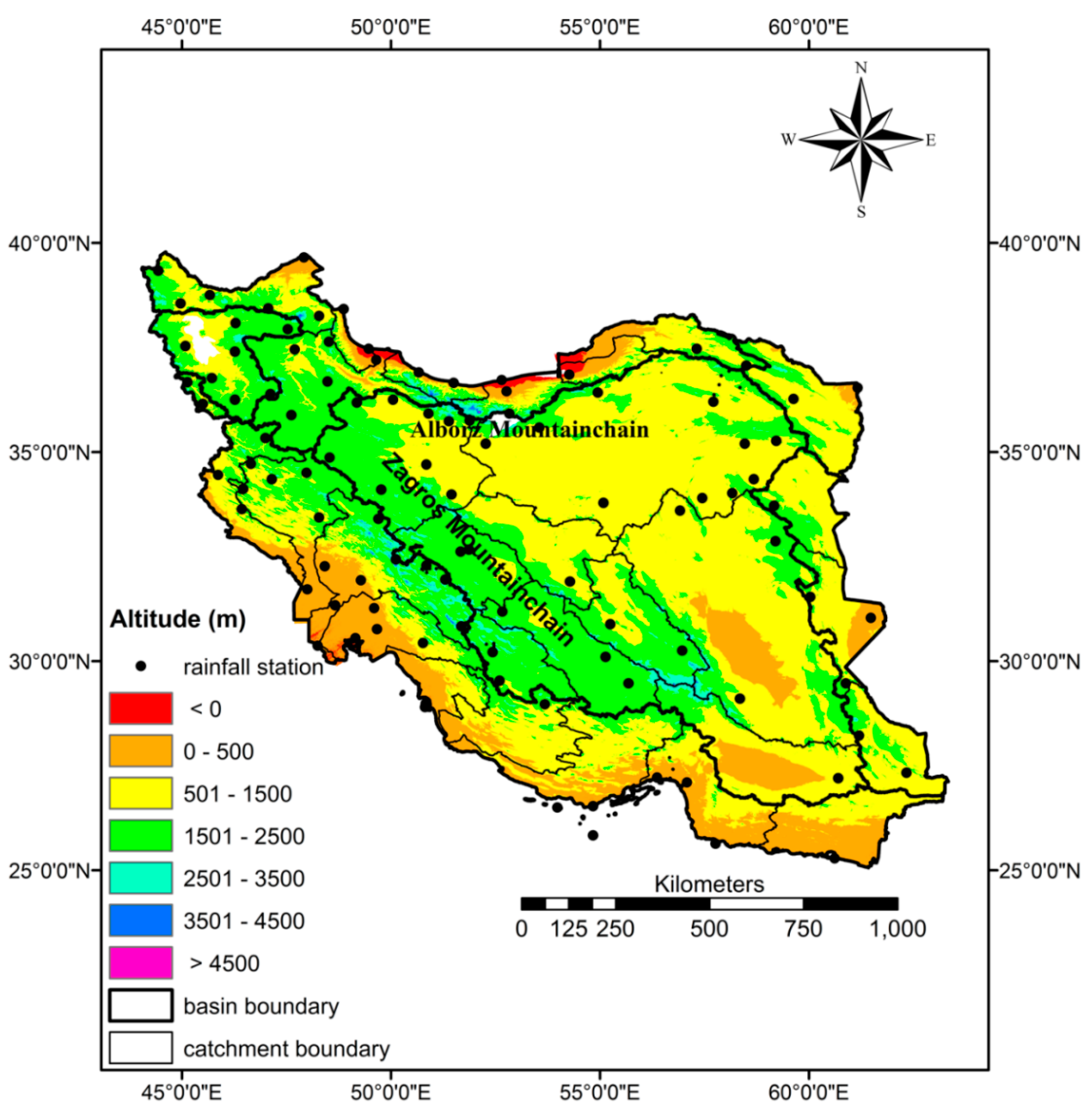

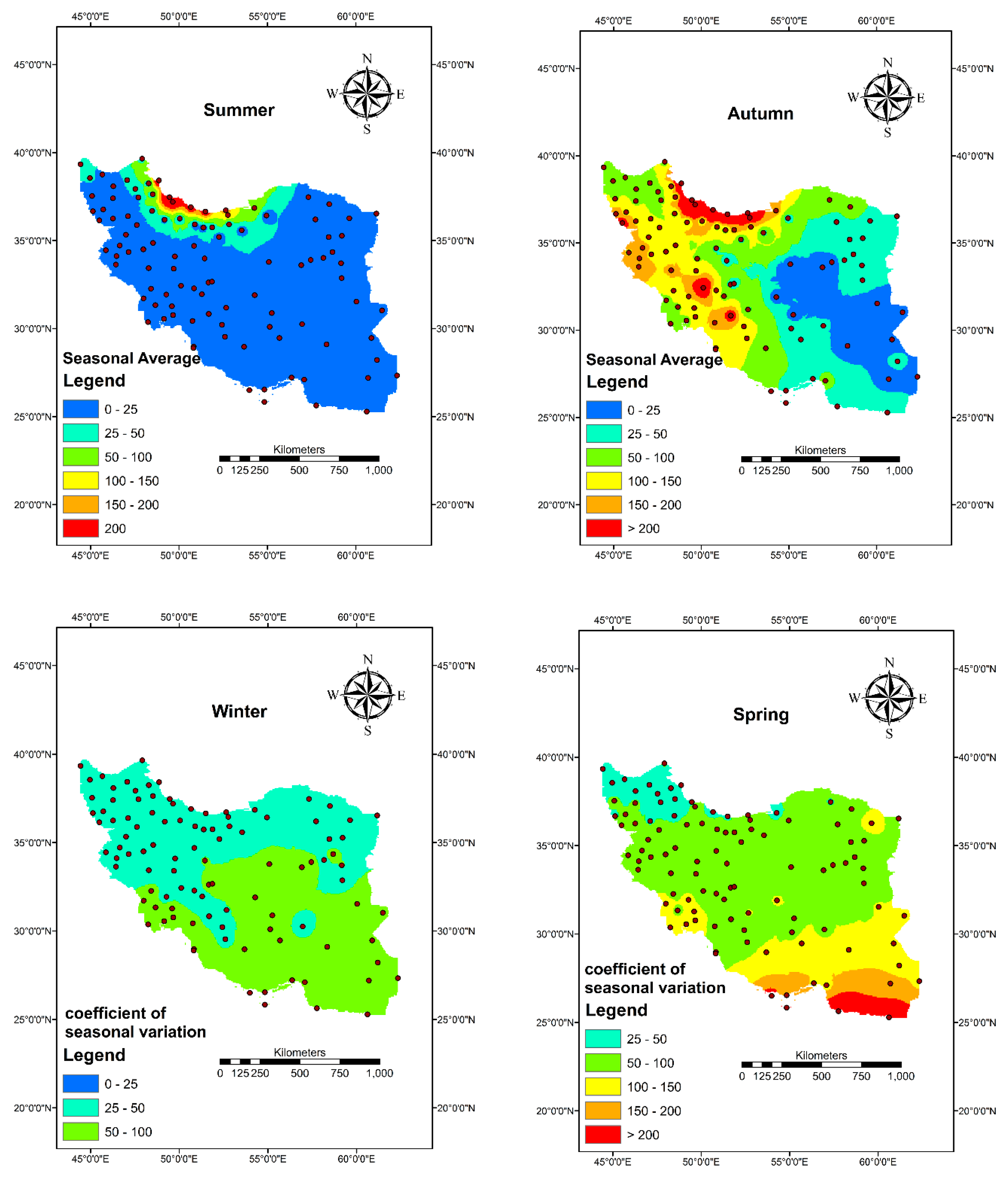
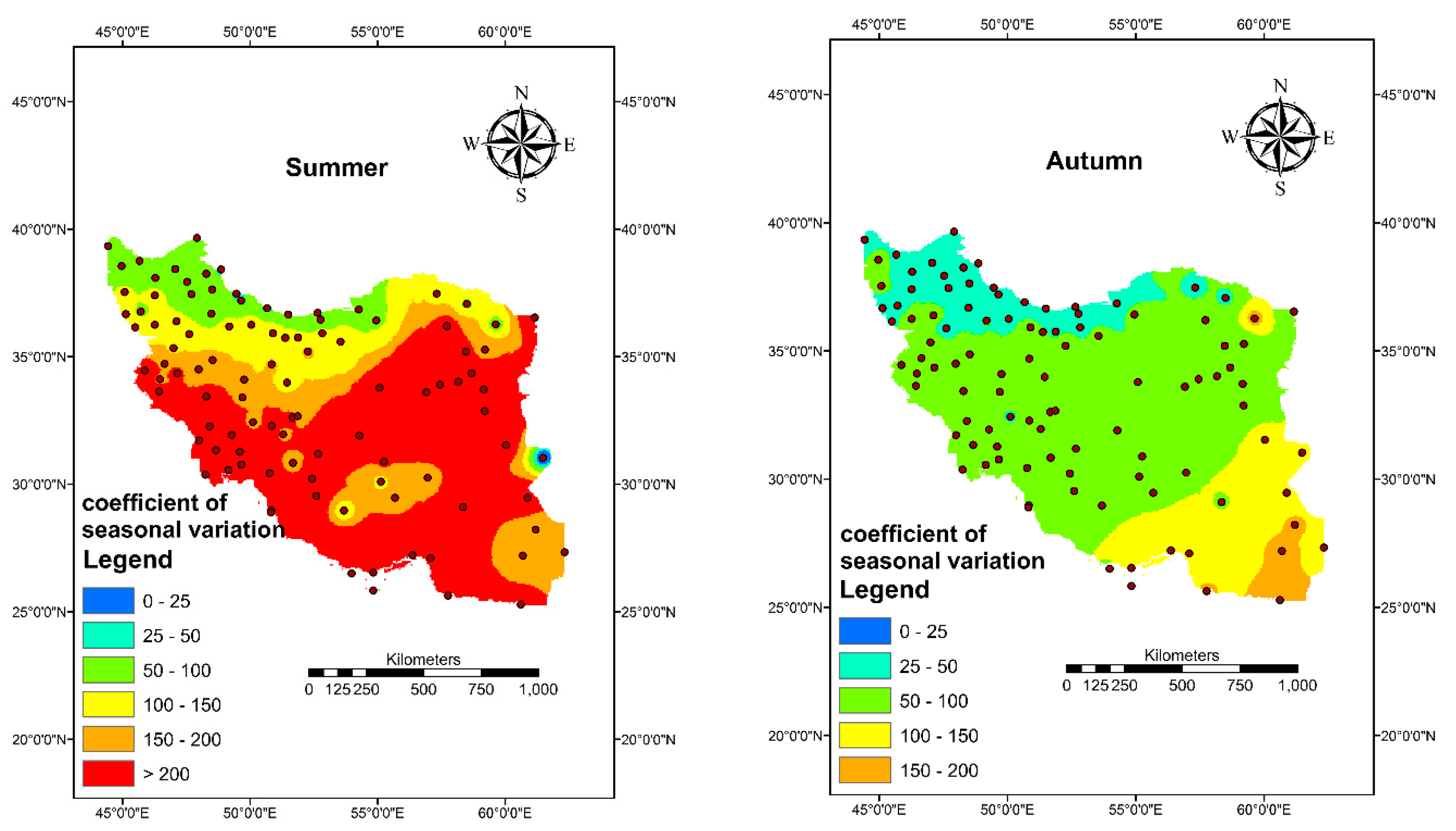
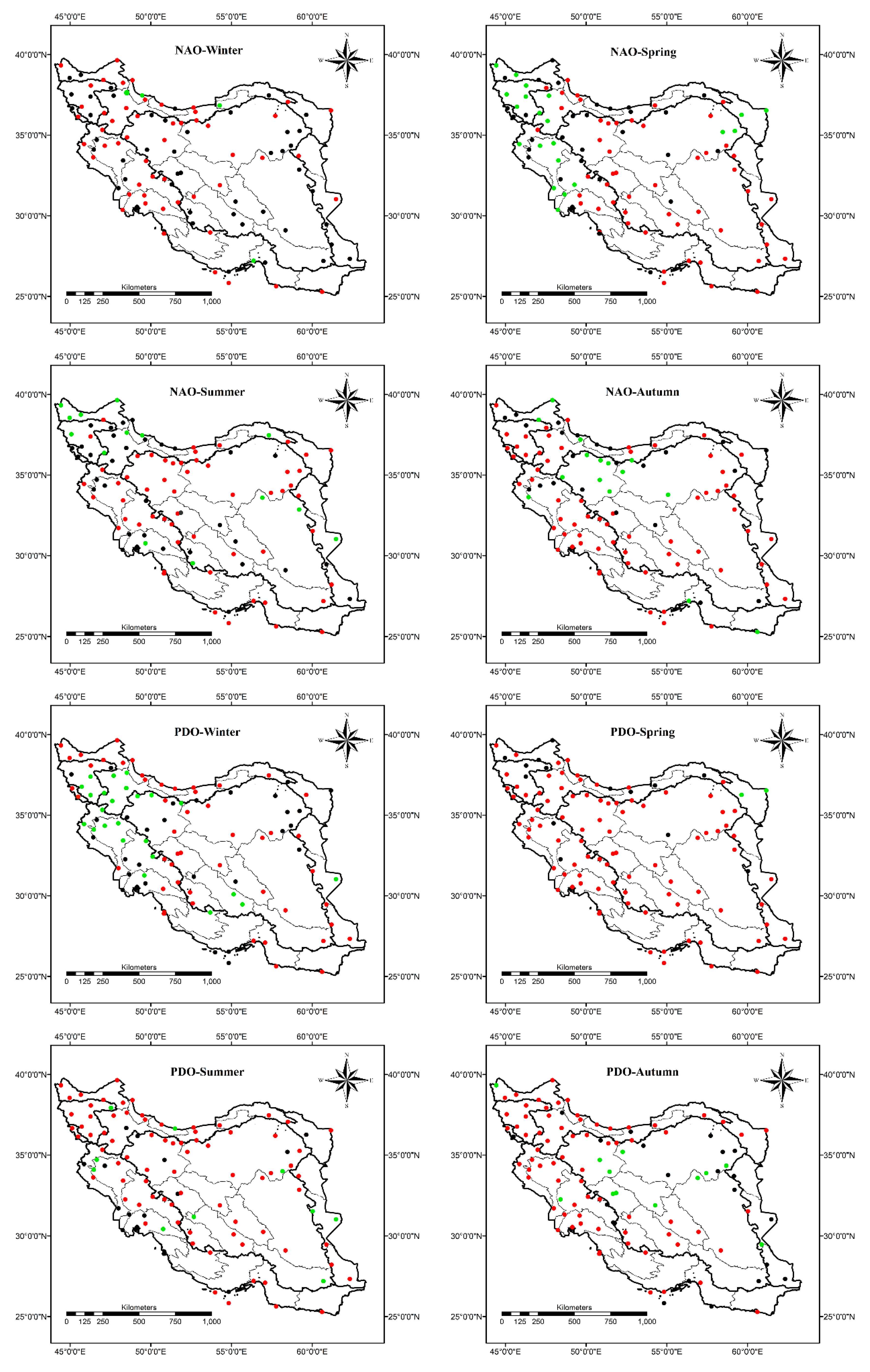
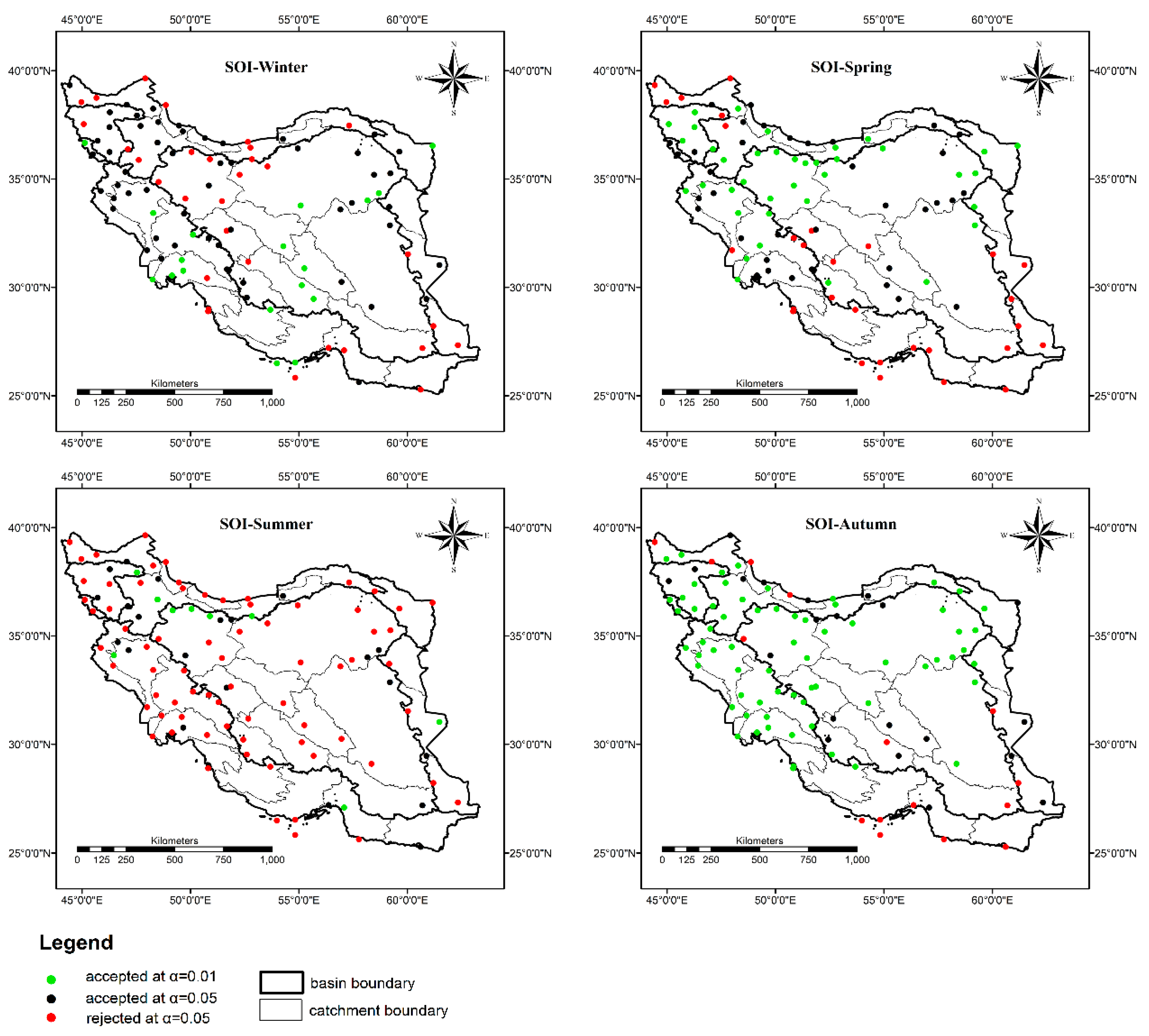
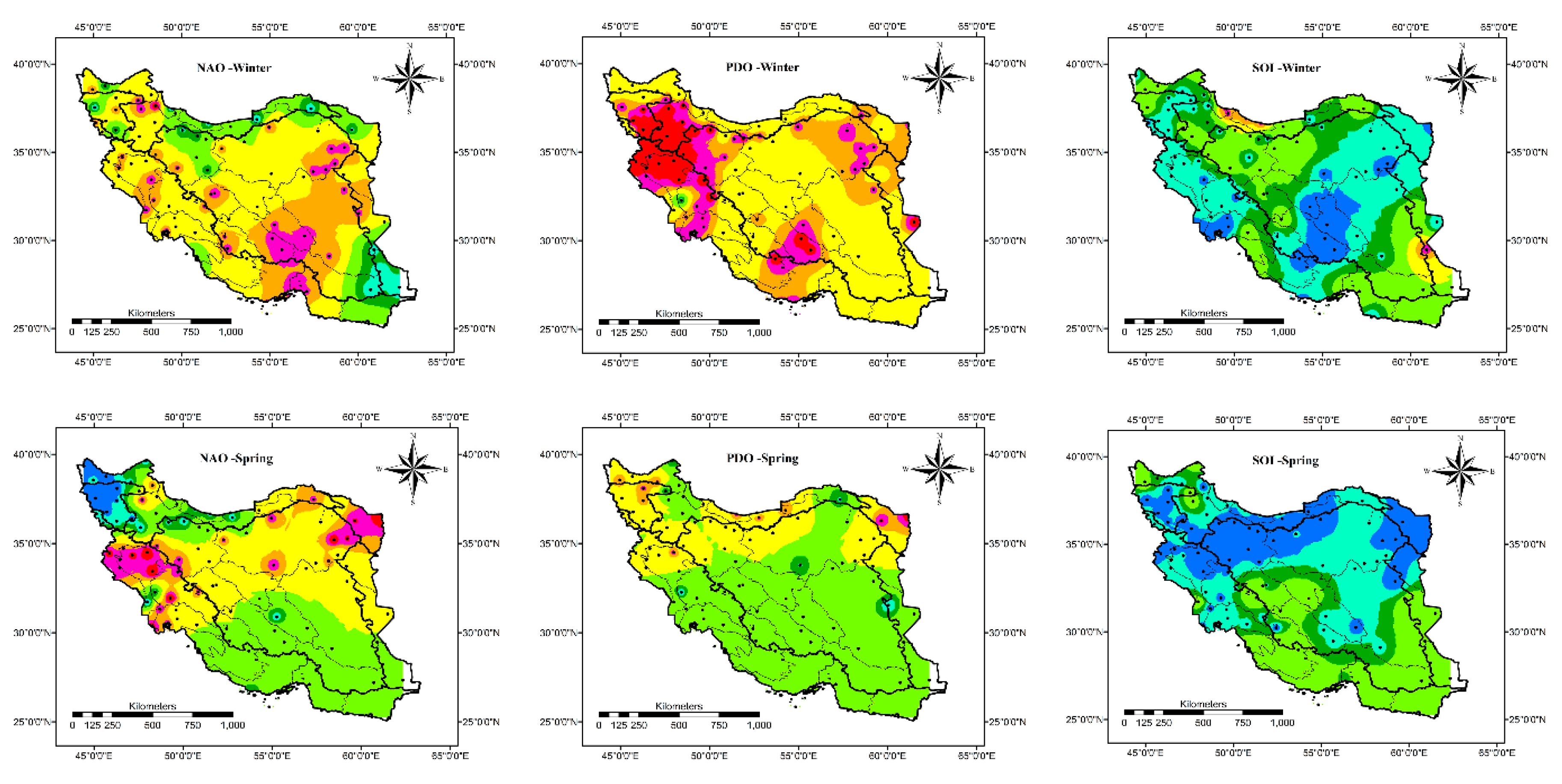
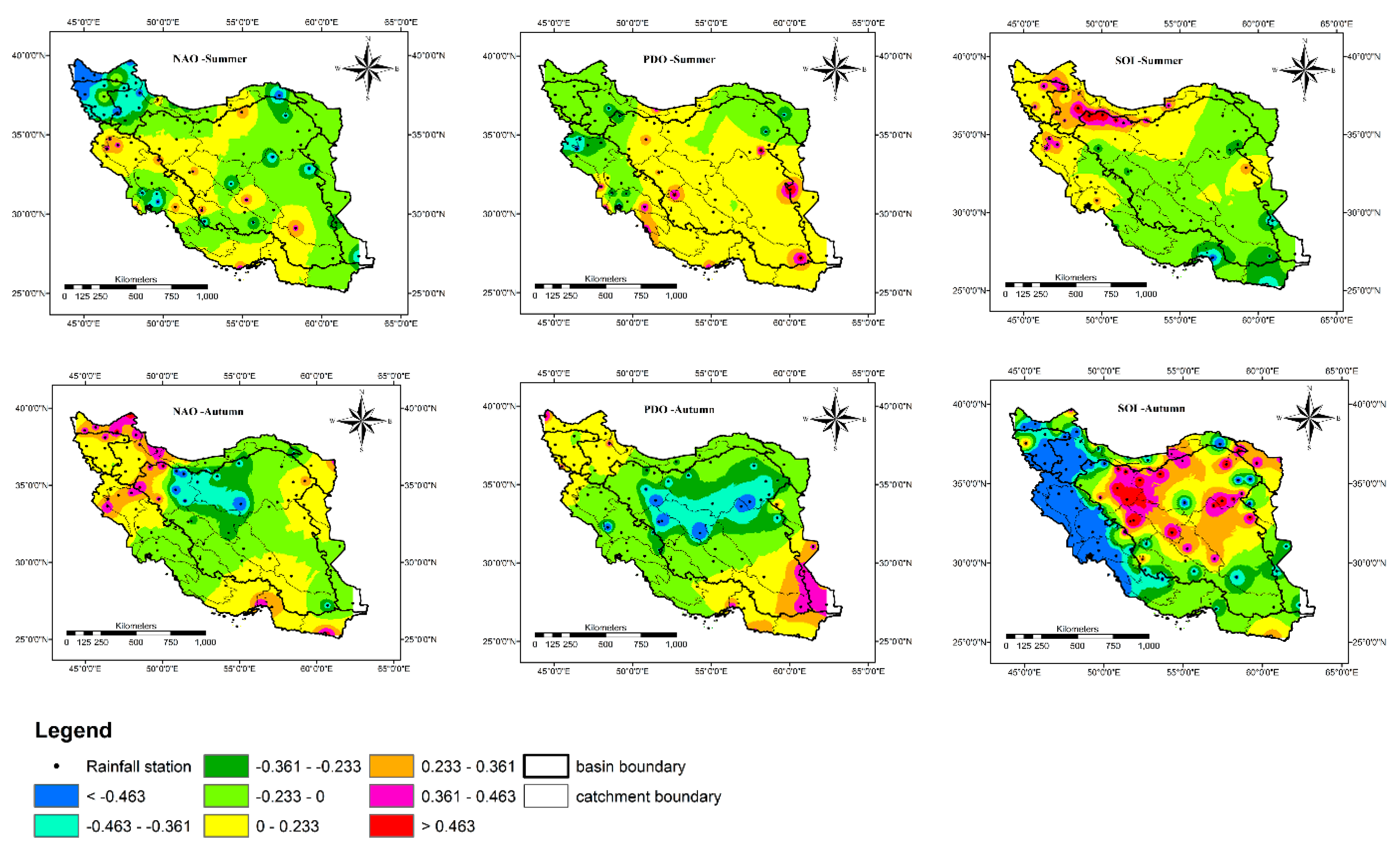
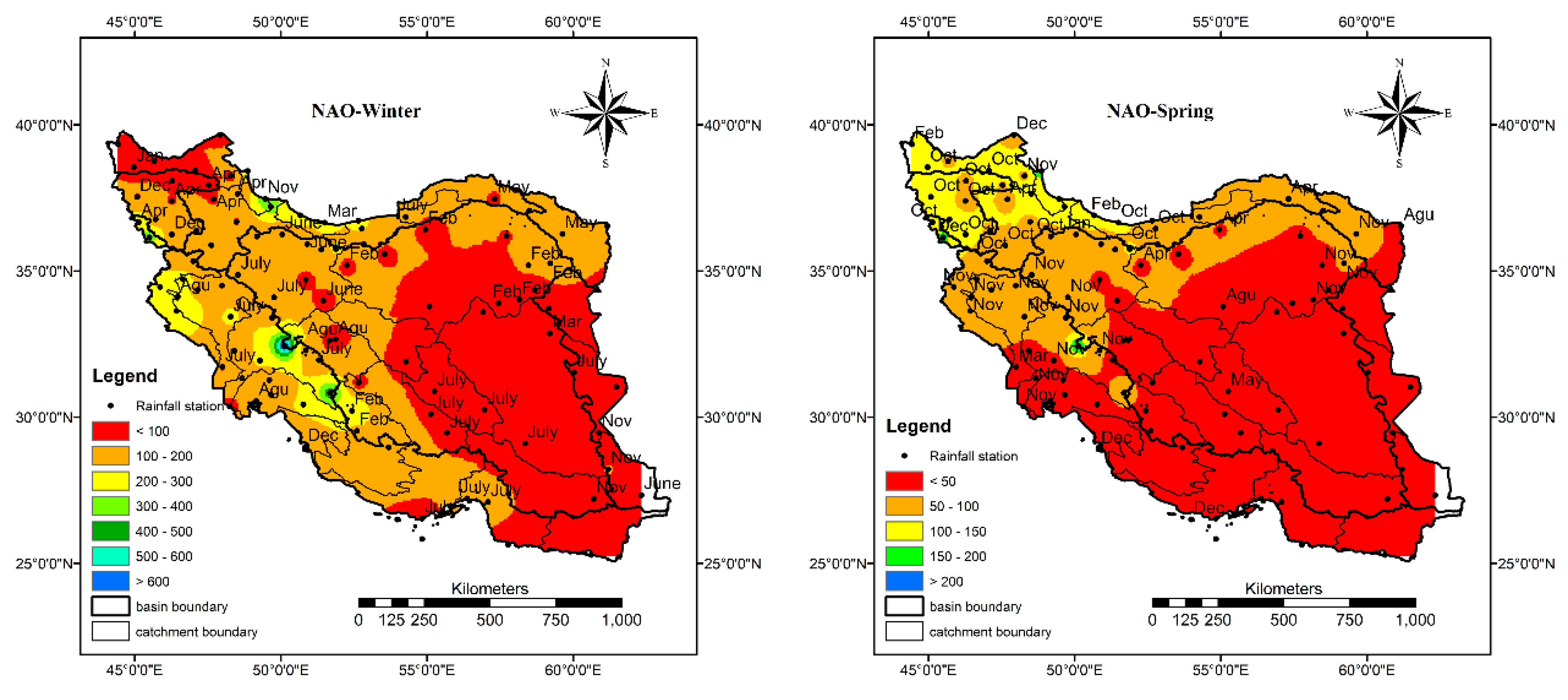
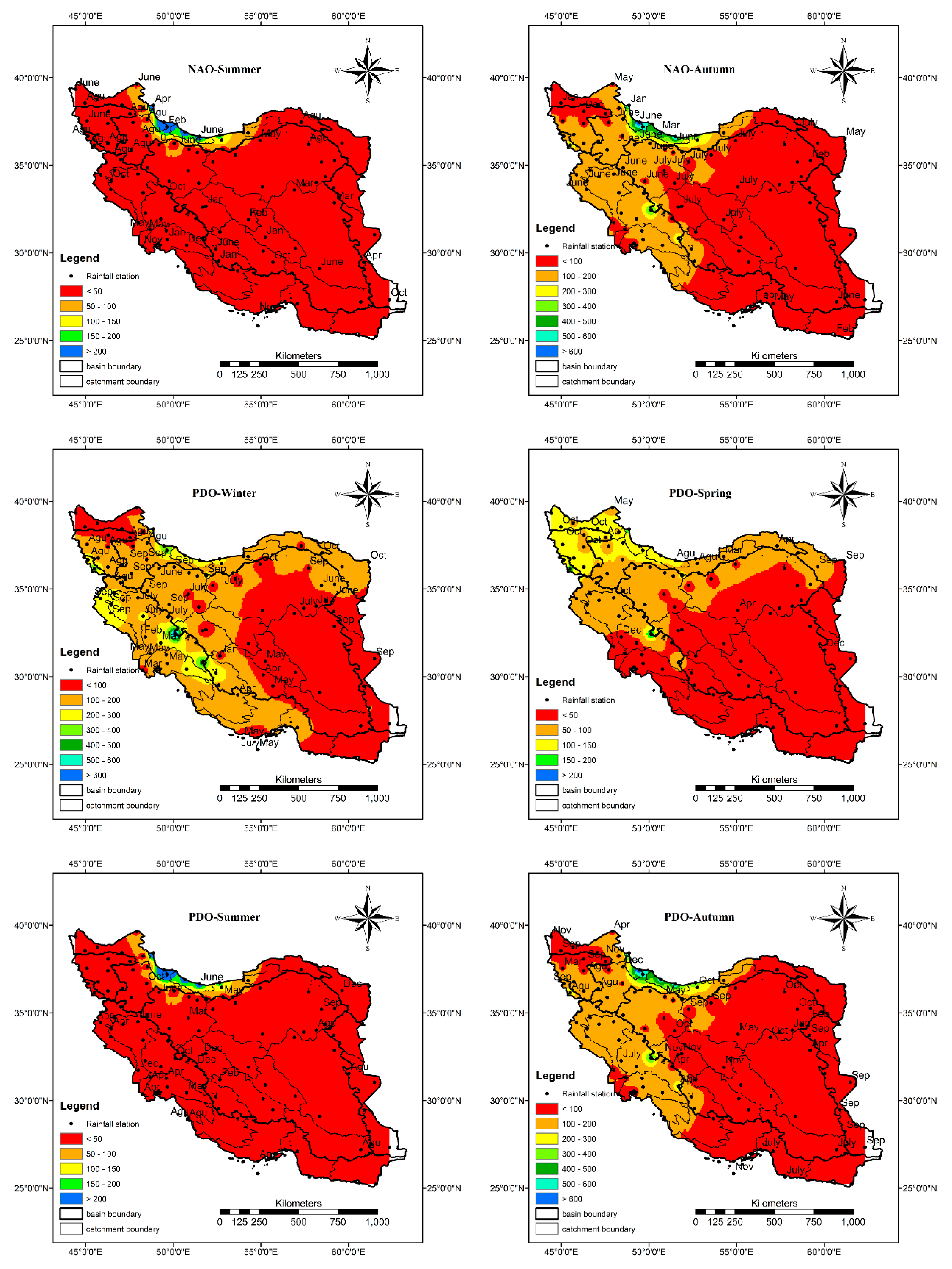
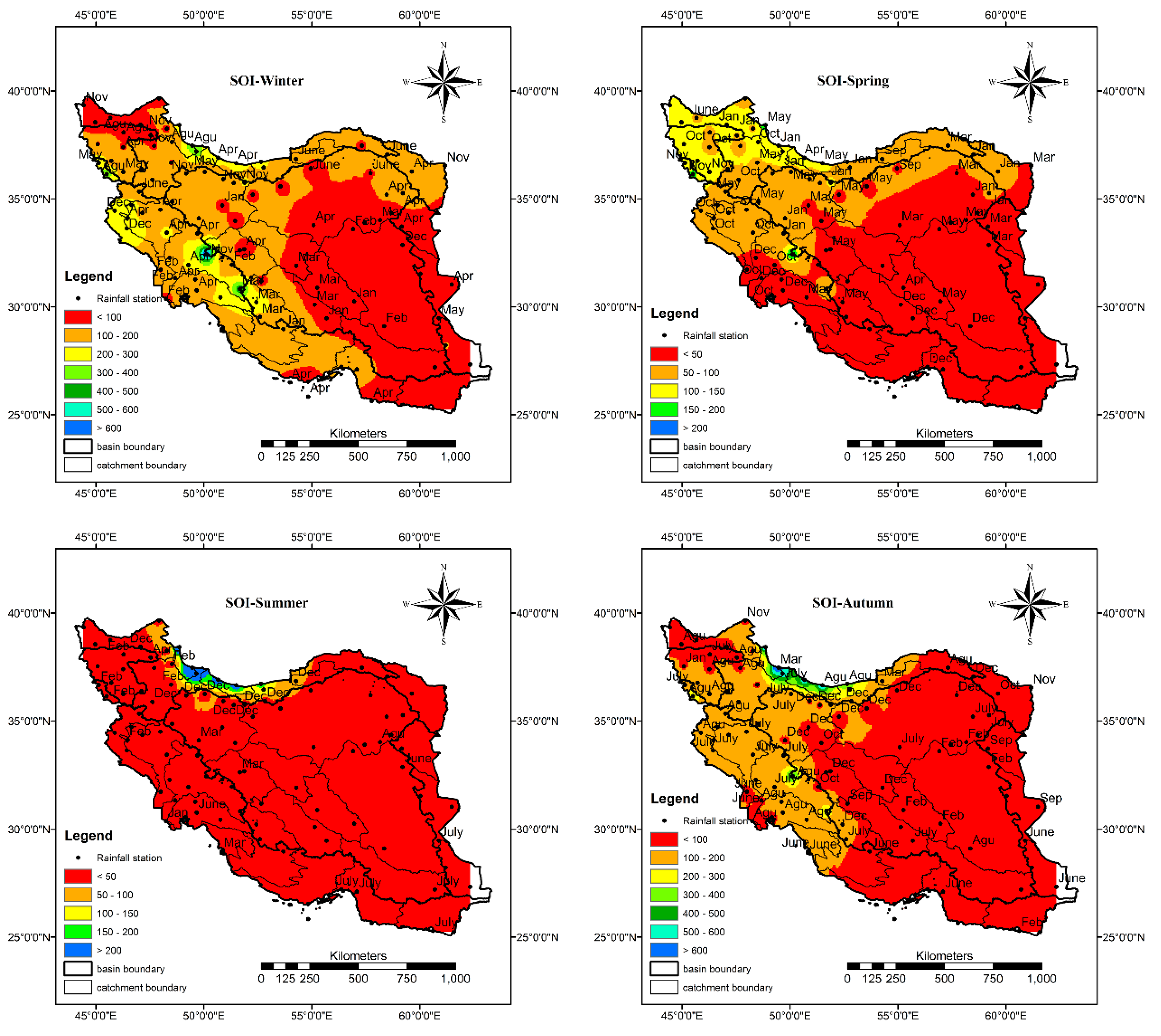
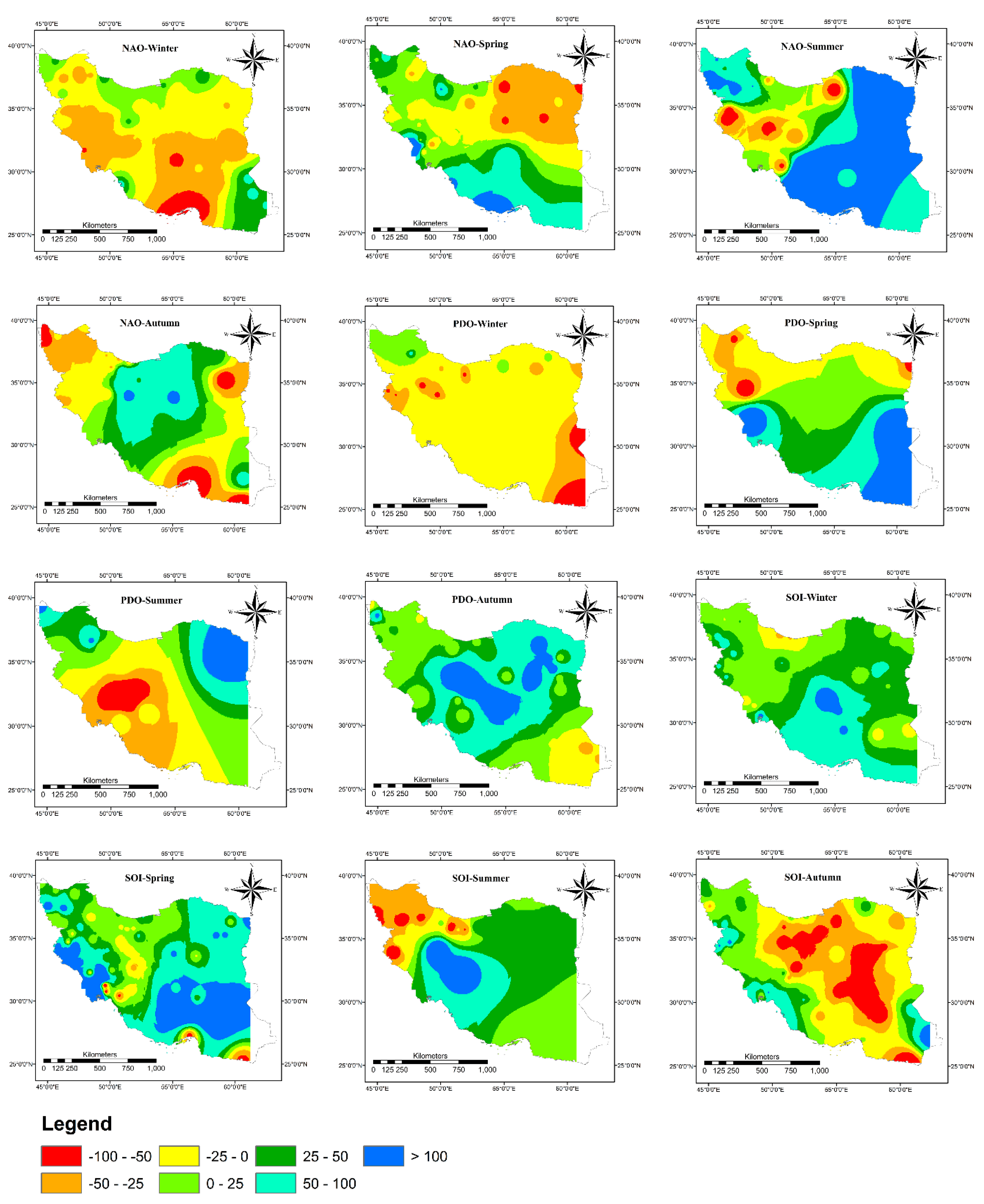
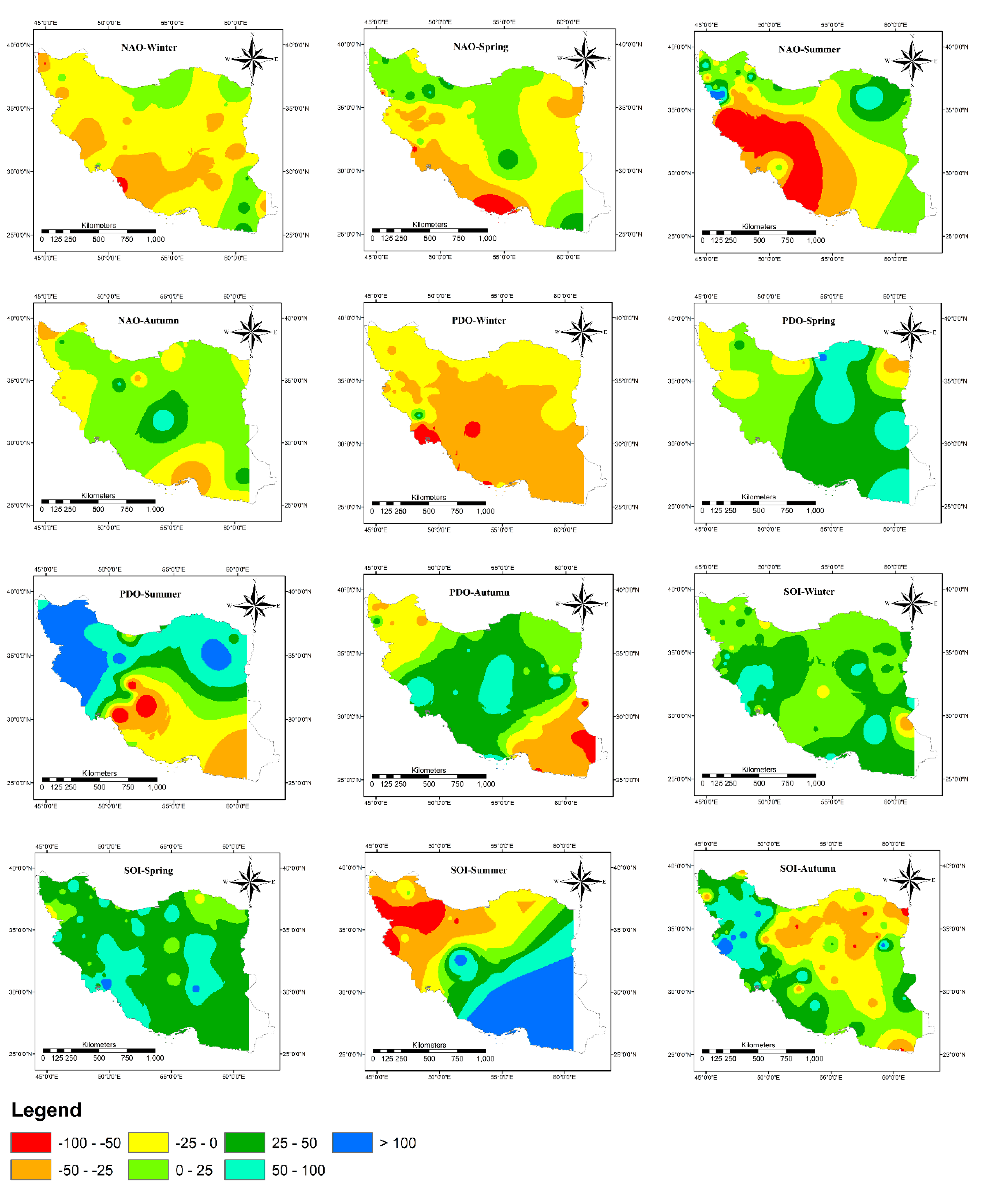

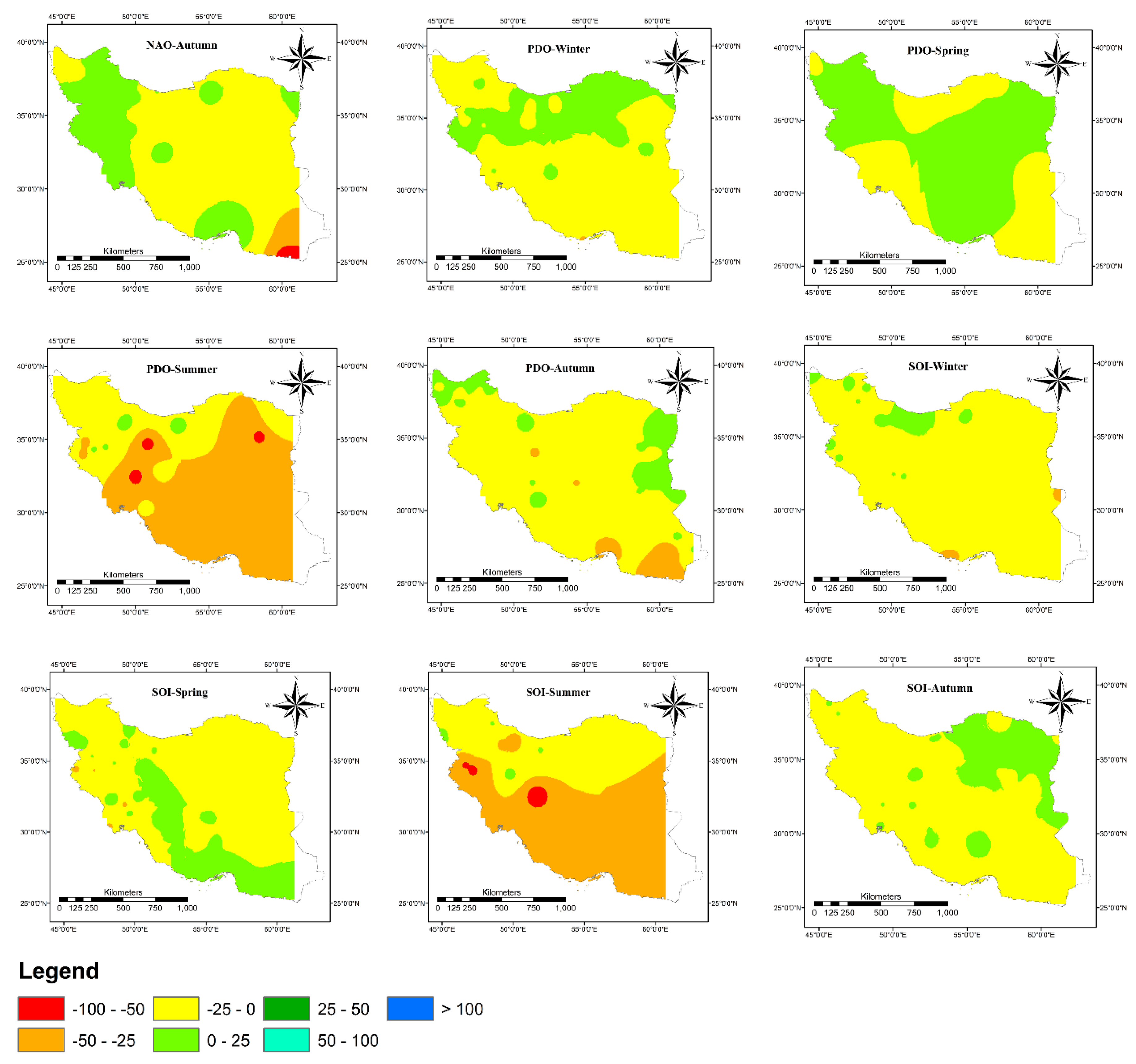

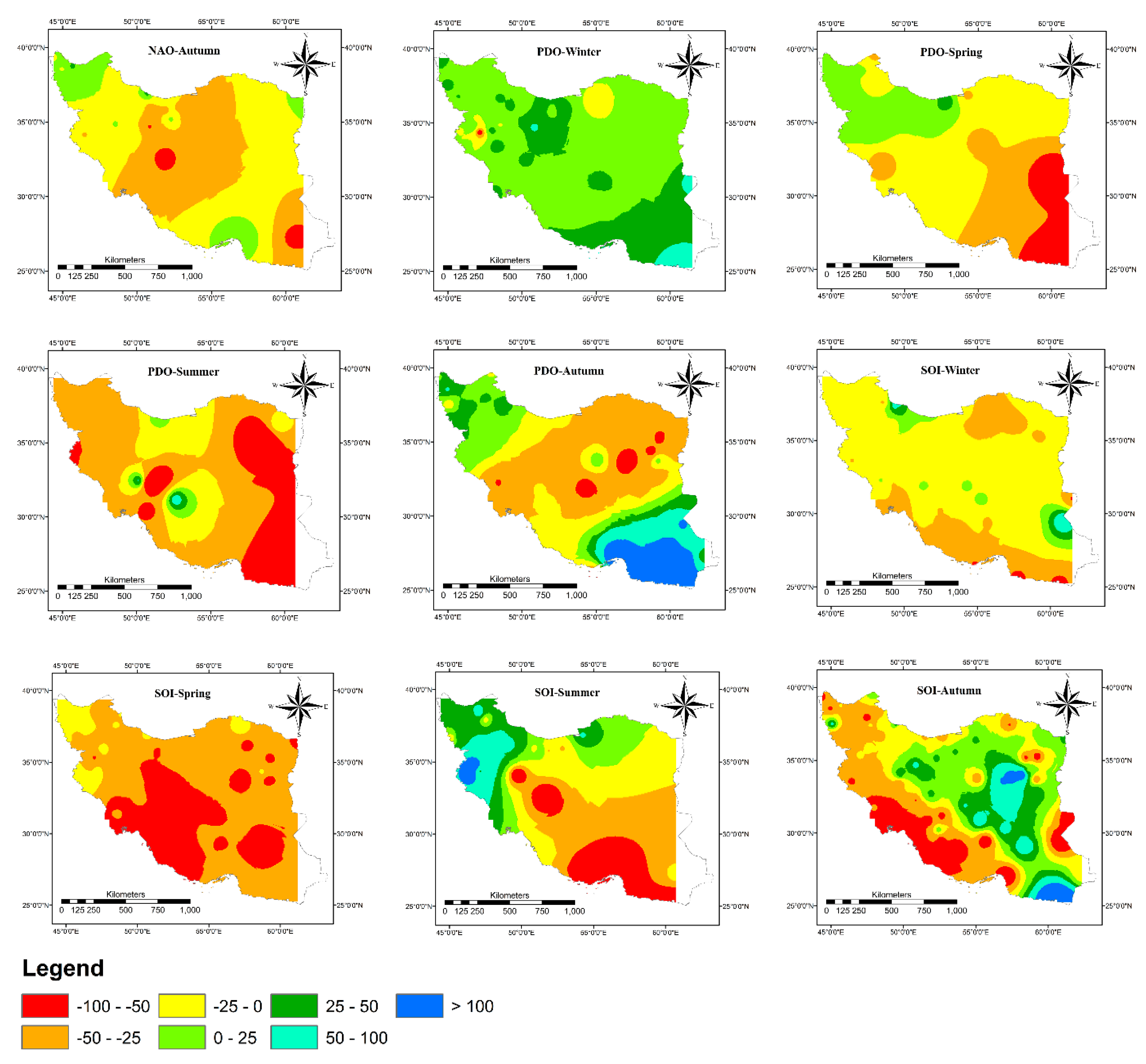

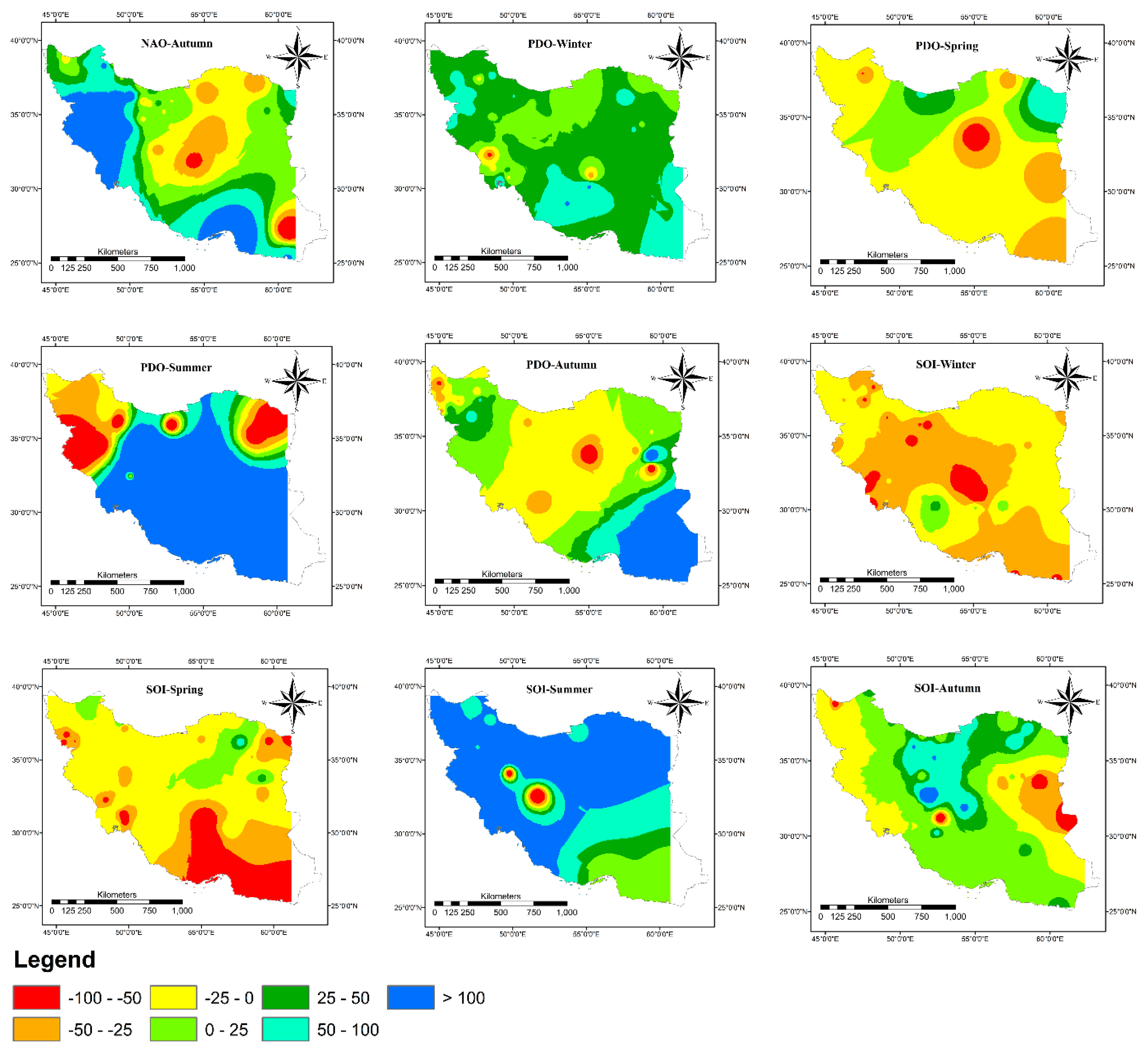
| Range of Indices | SOI | PDO | NAO |
|---|---|---|---|
| strong El Niño | Very warm | Very cold | |
| El Niño | Warm | Cold | |
| Neutral | Neutral | Neutral | |
| La Niña | Cold | Warm | |
| strong La Niña | Very cold | Very warm |
© 2020 by the authors. Licensee MDPI, Basel, Switzerland. This article is an open access article distributed under the terms and conditions of the Creative Commons Attribution (CC BY) license (http://creativecommons.org/licenses/by/4.0/).
Share and Cite
Dehghani, M.; Salehi, S.; Mosavi, A.; Nabipour, N.; Shamshirband, S.; Ghamisi, P. Spatial Analysis of Seasonal Precipitation over Iran: Co-Variation with Climate Indices. ISPRS Int. J. Geo-Inf. 2020, 9, 73. https://doi.org/10.3390/ijgi9020073
Dehghani M, Salehi S, Mosavi A, Nabipour N, Shamshirband S, Ghamisi P. Spatial Analysis of Seasonal Precipitation over Iran: Co-Variation with Climate Indices. ISPRS International Journal of Geo-Information. 2020; 9(2):73. https://doi.org/10.3390/ijgi9020073
Chicago/Turabian StyleDehghani, Majid, Somayeh Salehi, Amir Mosavi, Narjes Nabipour, Shahaboddin Shamshirband, and Pedram Ghamisi. 2020. "Spatial Analysis of Seasonal Precipitation over Iran: Co-Variation with Climate Indices" ISPRS International Journal of Geo-Information 9, no. 2: 73. https://doi.org/10.3390/ijgi9020073
APA StyleDehghani, M., Salehi, S., Mosavi, A., Nabipour, N., Shamshirband, S., & Ghamisi, P. (2020). Spatial Analysis of Seasonal Precipitation over Iran: Co-Variation with Climate Indices. ISPRS International Journal of Geo-Information, 9(2), 73. https://doi.org/10.3390/ijgi9020073






